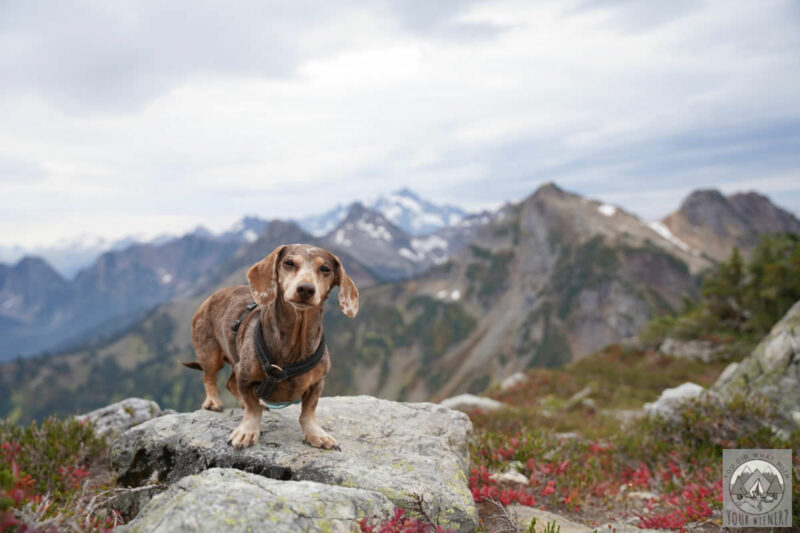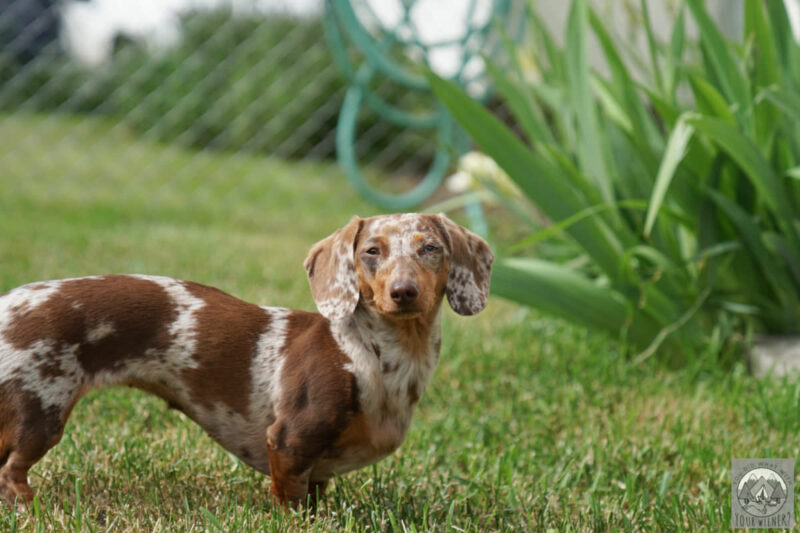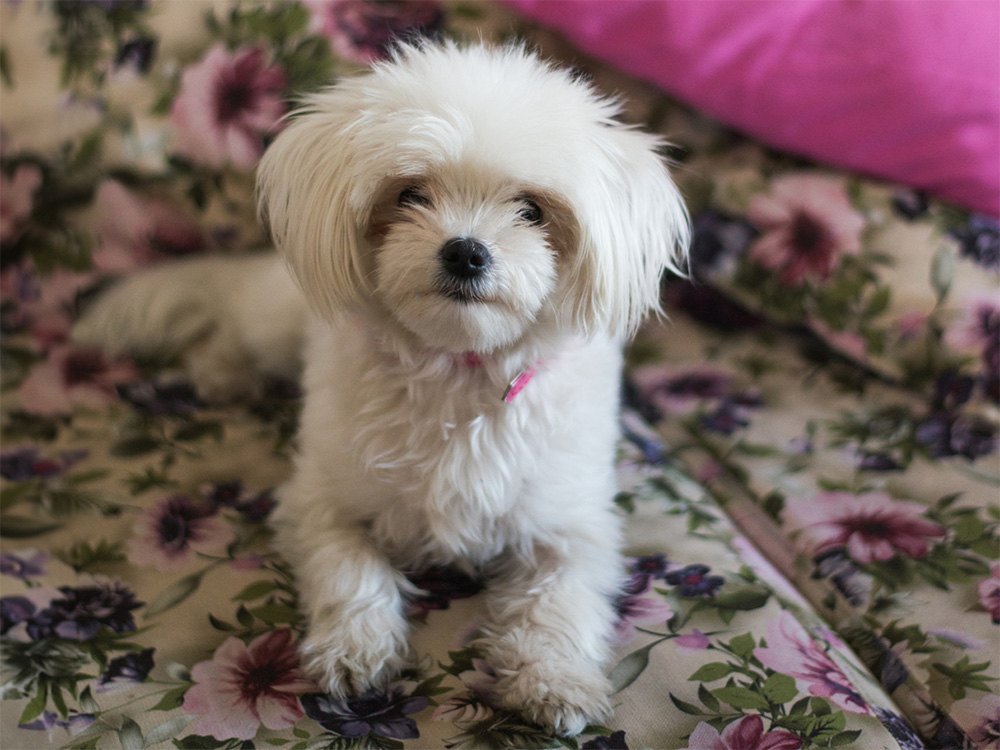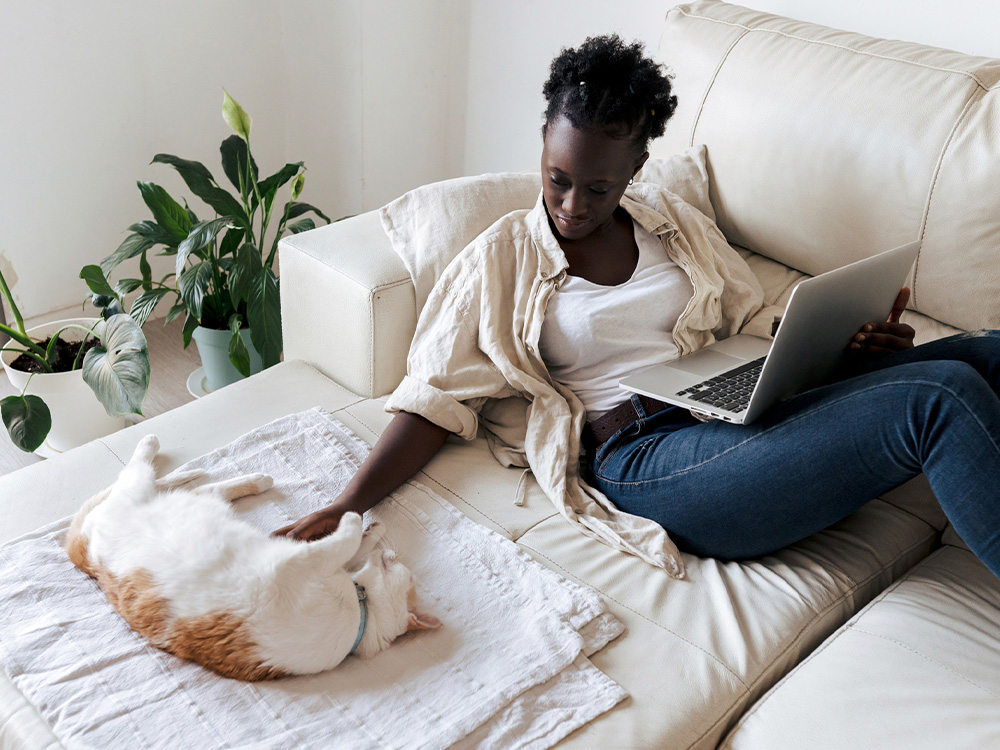The vet came out into the emergency waiting room and confirmed my worst fears: my Dachshund Gretel was diagnosed with Intervertebral Disk Disease (IVDD).
Our life together as I knew it flashed before my eyes. I was upset and sad. It was such a blow.
You see, Gretel had been my hiking partner for 5 years.
We made many memories in the mountains over hundreds of miles.
UPDATED: originally published march 29, 2016

Relying on each other out in the woods is what helped her get over her severe anxiety and helped create a bond between us that was stronger than I’d had with any dog before her.
Now, suddenly, that felt like a distant memory we would never be able to share again.
My next question for the vet is what could be done to help her heal and what was the prognosis.
Would she walk again? Could she live a normal life? Could she hike again?
If this sounds like you – you just received the dreaded diagnosis of IVDD – you might be wondering the same things as I did.
And if this is the first time you’ve heard of IVDD, you might be reeling from shock.
I’ve been studying IVDD since 2016, and have helped several Dachshunds through the rehab process, so I’m here to help ease your mind and outline what to expect for the next steps.
I know it’s easier said than done but don’t freak out!
IVDD and disk herniations are common in Dachshunds and the majority recover mostly or fully.
First, Know Your Dachshund’s Back Injury is Not Your Fault
In the majority of the cases I’ve heard of, Dachshund owners question and blame themselves for their Dachshund’s back injury.
But, you see, whether your Dachshund hurts their back or not is largely out of control.
Dachshund back injuries, when an acute injury like getting hit by a vehicle is not the cause, and especially if a dog is between the ages of 4 and 8, are due to Hansen’s Type I Intervertebral Disk Disease, or IVDD for short.
You can read the details in my article The Truth About Dachshund Back Problems but, in summary, IVDD is a genetic disease that weakens the spinal disks, which can result in a partial or full disk rupture (Intervertebral Disk Herniation – IVDH) and paralysis.
As an owner, you don’t have control over your dog’s genetics.



In the case of Dachshunds, close to 98% of them have some degree of IVDD because the disease is related to the gene that gives the Dachshund their signature long and low look.
But just because most Dachshunds are affected in some way by the disease, doesn’t mean they will suffer from a disk rupture.
In fact, only around 25% of Dachshunds will and those injuries can range from mild with only slight pain to severe with a loss of nerve feeling and paralysis.
While it is true that environmental factors, like diet, high impact, obesity, etc, do play a part in the frequency and severity of back injuries, if a disk is ready to rupture it will, no matter what you do or don’t do.
So, please, give yourself a break and focus your time and energy on your dog’s healing.
Assessment and IVDD Treatment Options – What to Expect
The next step after diagnosis of an IVDD-related disk herniation (IVDH) is a discussion with your veterinarian.
Your veterinarian will assess your dog’s mobility status and potential degree of nerve damage.
They will do this by pushing on your dog’s vertebrae, manipulating the back legs and hips, or front legs and head if the disk rupture is in the neck, and performing a “flip test” of the feet to see how fast your dog responds to being in an unnatural position.
After this evaluation, your vet will be able to give you an estimate of the degree of disk injury, and nerve damage, ranging from 1-5, although vets in the US typically diagnose at grades 2 or higher.
This IVDD grading score will help your vet to develop a treatment plan and give you an estimate of the outcome – the chance your dog will recover given a particular treatment – in percent.
Based on this assessment, your veterinarian will recommend one these 3 IVDD treatment options:
- Spinal surgery followed by conservative care and rehabilitation
- Conservative treatment (alone, no surgery)
- Euthanasia
An MRI may be suggested to better identify the affected disk and the degree of damage.
However, this is primarily to determine the exact disk that needs to be operated on so unless you agree to surgery right away, this is an optional procedure.
At stages 1 and 2, a veterinarian is most likely to suggest conservative treatment.
At stage 5, surgery or euthanasia is typically suggested.
For the in-between stages – stage 3 and 4 – a vet will typically suggest conservative treatment or surgery, based on your specific dog and where the compromised disk is located.
I want to note here that if you feel like your veterinarian is not knowledgeable about IVDD, and has not presented what you think are accurate and reasonable treatment options, consider seeking a second opinion.
Once your veterinarian has given you this information, it’s up to you to make the best choice based on your dog’s quality of life, what you can afford, and your ability to care for a dog with, potentially, special needs.
Evaluating the Treatment Options – Which One is Best?
I could write a novel on this the topic of IVDD treatments, or at least a small eBook, but I just want to offer an overview here, based on my knowledge and experience, instead of overwhelming you.
Also, these decisions most often have to be made quickly and under stress so I want to keep it simple.
First, you may be crushed if your vet suggests euthanasia is the best option or makes you feel like you should do it.
Know that this route is rarely a necessity, at least not without giving some treatment time to see how it goes.
The primary exception is if myelomalacia develops.
If this happens, it generally means that your Dachshund’s spinal cord has been severely damaged and is starting to die.
In this case, there is no cure and it can be very painful so putting your Dachshund to sleep will be the most compassionate thing to do.
But for the rest of the cases, you can tell your vet that you don’t want to go that route.
So the two options left are surgery or conservative treatment followed by rehab.
In the case of my Dachshund, Gretel, she was only stage 2 so surgery was not recommended for her. We went with conservative treatment.
We did not do an MRI because my vet said that is only necessary for worse cases where they need to know on which disk(s) surgery should be performed.
So know, that if your vet prescribes only conservative treatment, or you are not going to opt for surgery, paying a lot of money for an MRI is optional and probably not necessary.
But perhaps your veterinarian suggests surgery.
If they do, it’s probably because they think it will provide the best chance of recovery.
If surgery is suggested, it’s most effective when performed within 48 hours of the disk rupture.
However, the average cost of Dachshund back surgery is $10,000 and many can’t afford that.
If you can’t, do know that some Dachshunds have mostly or fully recovered with conservative treatment, and rehab, alone, even if surgery was the top recommendation.
In other words, even if surgery is recommended, it’s worth trying the conservative treatment route.
Also, if you do go with surgery, a period of crate rest and rehab is required afterward to completely heal.
Anyway, conservative treatment consists of a regimen of medications including a steroid, pain medication, and possible muscle relaxers, along with a minimum 5 weeks of very restricted movement often called “crate rest”.
Every dog has a different severity of injury, and will progress at different rates, so expect that crate rest could last as long as 6 months for fully paralyzed dogs.
Rehab can consist of many things ranging from massage and passive manipulation at home, to hydrotherapy or strengthening and muscle building exercises supervised by a rehab veterinarian.
During this rehab period, acupuncture, cold laser, or light therapy can also help promote healing.
What’s the Chance My Dachshund Will Recover?
Whether your Dachshund will recover from a disk rupture, and to what degree, primarily depends on your dog’s genetics, the level of treatment, how quickly that treatment was implemented, whether you stick with a sufficient period of restricted movement (crate rest), and some luck.
In my experience, dogs diagnosed with a grade 1 or 2 disk herniation will almost always recover, and recover completely, with conservative treatment.
Note: this doesn’t mean a different disk can’t rupture later or that there won’t be any flare-ups but a dog will generally go back to living a normal life.
Dogs with grades 3-4 that receive surgery tend to fully recover, although they may walk a little wonky for life.
A Dachshund who was grade 5 may never walk completely normal again after surgery but it’s definitely possible for them to after a period of 3-12 months.
In a best case scenario, short of recovering fully, a Dachshund will have minor mobility issues for the rest of their life. Most of these won’t affect their quality of life.
But it is also possible that a Dachshund who is paralyzed will never regain the ability to walk or urinate or defecate on their own.
I know several Dachshunds this has happened to but they still live a good life.
They happily scoot around the house with their front legs, sometimes in what is called a drag bag, to protect their legs from scrapes, and outside with the help of a wheelchair.
If they are not able to go potty on their own, you can help them go by doing what is called “expressing” their bladder or bowels.
But here is where we get real.
Ideally, you would be able to embrace this change and happily care for a handicapped Dachshund for the rest of their life.
But I am not going to shame anyone for recognizing that they simply can’t give a Dachshund with that many needs the quality of life they deserve.
If this is you, your options are to surrender your handicapped Dachshund to a rescue or euthanasia (yes, back to that dreaded option).
Can a Dog Recover From IVDD Without Surgery?
You may be wondering if your vet recommends surgery, if your Dachshund can still recover without it.
I want to drive this point home: IVDD is a disease. If your dog has it, they always will. They can’t recover from it.
Unfortunately, almost all Dachshund back injuries are referred to as IVDD, which is confusing.
When a Dachshund injures their back, it’s an intervertebral disk herniation (IVDH) caused by IVDD.
So the real question here, is can a Dachshund recover from IVDH without surgery.
Now, back to our regularly scheduled program.
The truth is that the success rate for surgery is usually somewhere between 50% and 95%.
The higher the grade of disk herniation, the lower the percentage they will fully recover, in general.
That means that even if you opt for the surgery, there is not a 100% chance your Dachshund will fully recover.
To help you decide whether you want to go the surgery route or not, your vet should be able to give you this estimate of recovery for your individual dog.
But the figures below will also be helpful.
The chance of recovery through conservative treatment alone, for dogs diagnosed as grades 4 and 5, the most severe cases and when surgery is most typically recommended, is 30% to 80%.
Given that surgery on the same dog generally gives a 50% to 90% chance of recovery, those numbers are not too far off from each other.
Based on those numbers, and my experience, it is definitely possible for a Dachshund to recover from a disk herniation without surgery.
But do be aware that, if surgery is recommended as the best option and you decline in lieu of conservative treatment, it’s also possible that they won’t.
Complementary Treatments for IVDD to Consider
I previously stated that there are 2 treatments, and 3 options, for an IVDD-related disk herniation but that’s not completely true.
There are some others. They’re not common, readily available, or always financially viable, but I want you to at least be aware they exist.
These include:
- Stem cell treatment
- Percutaneous laser disk ablation (PLDA), also known as Percutaneous laser disc decompression (PLDD)
- Hyperbaric oxygen chamber (to speed recovery)
- Acupuncture
- Cold laser therapy
I worked with Dr. Leslie Eide, DVM, CCRT, with The Total Canine Rehabilitation and Sports Medicine from Marysville, WA during Gretel’s recovery and asked her about all of these treatment options.
Dr. Eide owns two award-winning agility dogs, and is an athlete herself, so she is very familiar with an athletic lifestyle and sports injuries.
Dr. Eide recommended that we try acupuncture and laser therapy since those were relatively affordable, readily accessible, and had a track record of being effective.
We started cold laser therapy immediately, 2 times a week, to help reduce pain and inflammation and speed healing.
Acupuncture, which we did once a week for 6 weeks, also helps with the body’s healing process.
Dr. Eide said stem cell therapy, although a potential option, would be complicated, expensive, and there is no reasonable guarantee that it would help more than some of the other treatment options.
I asked about treatment in a hyperbaric oxygen chamber to speed recovery but Dr. Eide said it was A) not available in Seattle that she knew of (although it’s my understanding it is at Washington State University in Pullman, WA) and B) better for severe neurological cases.
PDLA, although available since the late 90’s, was not something I was aware of at the time of Gretel’s IVDD diagnosis in 2016.
PDLA, which is performed to prevent IVDD-related disk herniations can’t be performed on a dog with an active spinal injury, so it wouldn’t have been an option for us at the time anyway.
Gretel has been very active and only had 3 significant IVDD flare ups in the last 6 years, so PDLA was not something I pursued but I would definitely consider it in the future for another Dachshund.
I know a few people who got the procedure for their Dachshunds because their dog kept rupturing disks, and they all rave about how much the procedure helped prevent future issues.
Final Thoughts
When your Dachshund is in pain, wobbly on their legs, or paralyzed, and then you receive a diagnosis of IVDD, it can be devastating.
You may feel scared, hopeless, sad and like your Dachshund will never live a normal life again.
But back injuries are common in Dachshunds and many, many have fully, or mostly, recovered.
Luckily, too, the veterinary world is learning more and more about treatment for IVDD and disk herniations.
I know many Dachshunds who have suffered a disk herniation, been diagnosed with IVDD, fully recovered, and gone on to live an active life.
Like my Dachshund Gretel.
Once her 10 weeks of crate rest and rehab were completed, we were able to resume our normal activities, including hiking.
Since her recovery in 2016, she has hiked up to 15 miles in one day on multiple occasions and completed a 30 mile hike over a period of 3 days.
On her own. I didn’t have to carry her.
So, relax, breathe, focus on treatment and moving forward, and give your baby a hug. There is hope things can go back to normal.



